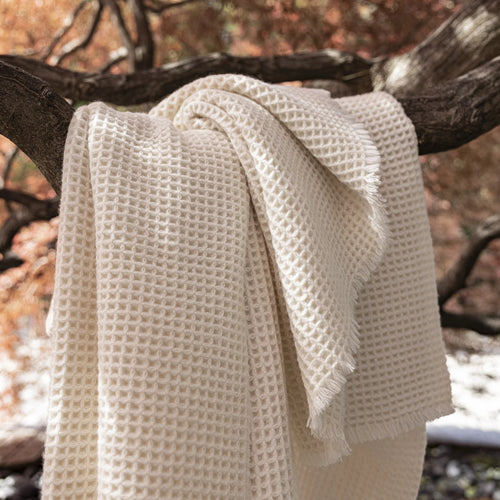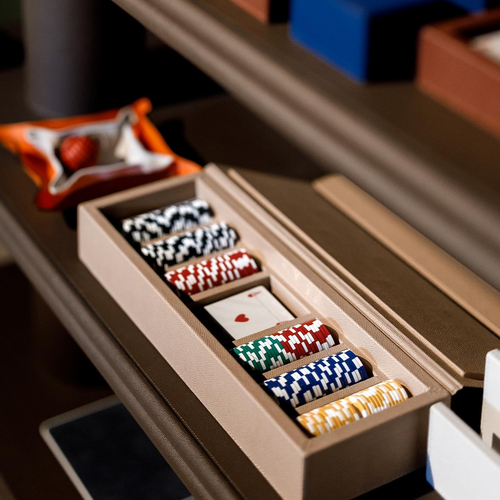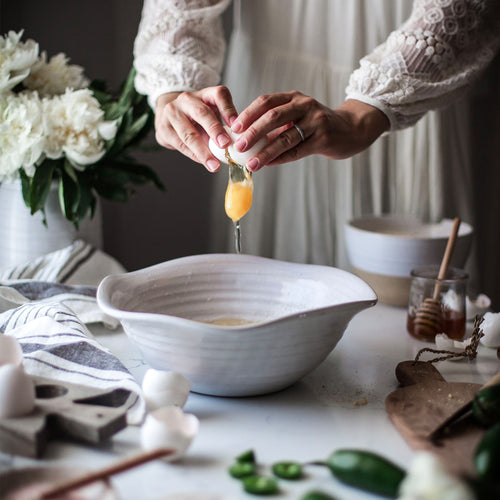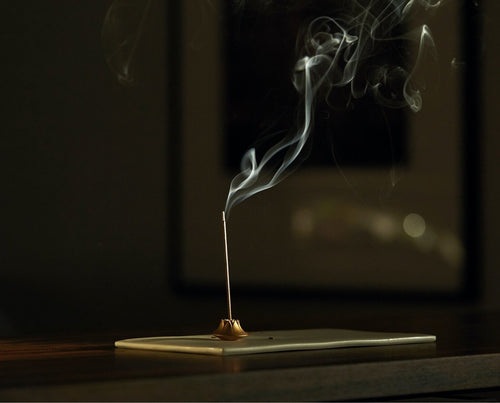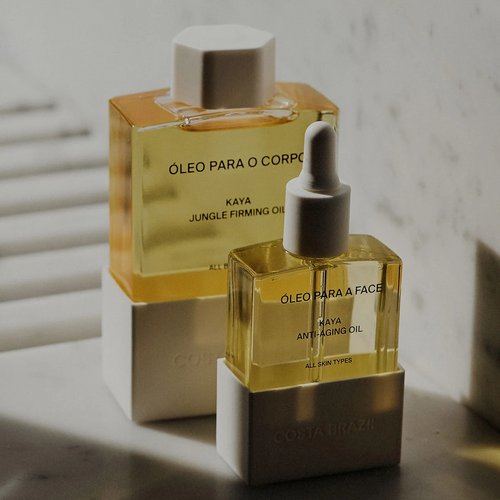GDV Picks: The Best Recipes To Transition From Summer To Fall

It's no secret that we love the delicious + unique gastronomic experience of Ottolenghi. A perfect blend between traditional recipes + middle eastern inspired flavor, his combination of spices are so simple, and yet have so much depth.
As we look to find the perfect recipes for the transitional period between the end of summer and the beginning of autumn, we HAVE to look towards some of our favorites from the famed, London-based chef. Swipe down to discover our GDV go-to's as well as some chic servingware pairings for each dish.
Farro and roasted red pepper salad

INGREDIENTS
100g farro
2 red peppers
10 marinated pitted black olives, quartered lengthways
1 tbsp chopped fresh oregano (or picked thyme leaves)
3 spring onions, thinly sliced
100g feta, broken into large chunks
For the dressing:
Juice of 1 medium lemon
3 tbsp olive oil
1 tbsp honey
½ tsp ground allspice
½ tsp smoked paprika, plus extra
½ garlic clove, crushed
½ tsp fine sea salt
METHOD
- Put the farro in a pot of boiling water and simmer until just tender. Strain, refresh and leave to dry.
- Meanwhile, prepare the peppers. Cut around the stalk of each pepper and lift it out with seeds attached. Put the peppers on an oven tray, place under a very hot grill and char, turning every now and then, until totally black on the outside (this will take 30 minutes or more). Remove from the oven and cover the tray with foil. Once cool enough to handle, peel the peppers and tear the flesh into 1cm wide strips.
- Whisk all the dressing ingredients in a bowl and set aside.
- Put the farro in a big bowl and add the peppers, olives, oregano, spring onion and most of the feta. Pour over the dressing and gently mix together. Taste, and add more salt if you like. To serve, pile up the salad on a plate or in a bowl, and finish with the remaining feta and a sprinkling of paprika.
Pairs Well With
Whole black bream with pine nuts and lemon

INGREDIENTS
2 medium black bream (or bass), scaled and gutted
For the marinade:
100ml olive oil, plus extra to drizzle over the fish
75ml lemon juice
3 tbsp paprika
1½ tsp cayenne pepper
4 garlic cloves, crushed
1 tbsp coarse sea salt
For the stuffing:
150g short grain rice
150ml water
2 garlic cloves, crushed
½ medium onion, finely chopped
1 celery stick, finely chopped
½ preserved lemon, flesh only, finely chopped
60g toasted pine nuts
½ tsp cinnamon
½ tsp allspice
½ tsp paprika
½ tsp coarse sea salt
For the potatoes:
6 medium desirée potatoes
2 medium lemons, thinly sliced, pips removed
Lemon wedges (optional), to garnish
METHOD
- Put the fish in a long container. Whisk together the marinade ingredients, pour over the fish and leave for at least 30 minutes and up to two hours.
- Meanwhile, make the stuffing. Put the rice and water in a small saucepan and simmer, covered, on very low heat for 10 minutes - the rice should almost cook through. Let it cool down a little, then mix with the remaining stuffing ingredients. Set aside.
- Preheat the oven to 220C/425F/gas mark 7. Peel the potatoes and cut into 0.5cm thick slices. Put in a saucepan, cover with water and boil for about six minutes, to soften. Drain, refresh under cold water and leave to dry.
- Lift the fish from its marinade and transfer to a plate. Put the cooked potatoes and slices of lemon into the marinade, toss gently to coat, then spread evenly inside a roasting tray that's large enough to accommodate the fish. Bake for 12 minutes, until the potatoes begin to take on some colour or the lemon starts to dry out.
- In the meantime, fill the fish with the stuffing. Lay this on top of the hot potatoes, drizzle with oil and sprinkle a couple of tablespoons of water over the potatoes. Turn down the oven to 200C/400F/gas mark 6. Cover the tray with aluminium foil, then return to the oven for 30 minutes. Remove the foil and cook for five to 15 minutes more, depending on the size of the fish. It's done when the stuffing is hot and the fish flesh bounces back when you press it.
- Serve straight from the tray, with extra lemon wedges, if you wish, though it's pretty lemony as it is.
Pairs Well With
Roasted chicken with clementines & arak

INGREDIENTS
100ml arak, ouzo or Pernod
4 tbsp olive oil
3 tbsp freshly squeezed orange juice
3 tbsp lemon juice
2 tbsp grain mustard
3 tbsp light brown sugar
2 medium fennel bulbs (500g in total)
1 large organic or free-range chicken, about 1.3kg, divided into 8 pieces, or the same weight in chicken thighs with the skin and on the bone
4 clementines, unpeeled (400g in total), sliced horizontally into 0.5cm slices
1 tbsp thyme leaves
2½ tsp fennel seeds, slightly crushed
salt and black pepper
chopped flat-leaf parsley, to garnish
METHOD
- Put the first six ingredients in a large mixing bowl and add 2½ teaspoons of salt and 1½ teaspoons of black pepper. Whisk well and set aside.
- Trim the fennel and cut each bulb in half lengthways. Cut each half into 4 wedges. Add the fennel to the liquids, along with the chicken pieces, clementine slices, thyme and fennel seeds. Stir well with your hands then leave to marinate in the fridge for a few hours or overnight (skipping the marinating stage is also fine, if you are pressed for time).
- Preheat the oven to 220C/gas mark 7. Transfer the chicken and its marinade to a baking tray large enough to accommodate everything comfortably in a single layer (roughly a 30cm x 37cm tray); the chicken skin should be facing up. Once the oven is hot enough, put the tray in the oven and roast for 35-45 minutes, until the chicken is coloured and cooked through. Remove from the oven.
- Lift the chicken, fennel and clementines from the tray and arrange on a serving plate; cover and keep warm. Pour the cooking liquids into a small saucepan, place on a medium-high heat, bring to the boil then simmer until the sauce is reduced by a third, so you are left with about 80ml. Pour the hot sauce over the chicken, garnish with some chopped parsley and serve.
Pairs Well With
Roasted aubergine with curried yoghurt

INGREDIENTS
3 large aubergines (or 4 regular) (1.1kg)
100ml groundnut oil
200g Greek-style yoghurt
2 tsp medium curry powder
¼ tsp ground turmeric
1 lime: finely grate the zest to get 1 tsp, then juice to get 2 tsp
1 onion, thinly sliced (150g)
30g flaked almonds
½ tsp cumin seeds, toasted and lightly crushed
½ tsp coriander seeds, toasted and lightly crushed
40g pomegranate seeds
salt and black pepper
METHOD
1. Preheat the oven to 220°C fan.
2. Use a vegetable peeler to peel away strips of aubergine skin from top to bottom, leaving the aubergines with alternating strips of black skin and white flesh, like a zebra. Cut widthways into round slices, 2cm thick, and place in a large bowl. Mix well with 70ml of oil, ½ teaspoon of salt and plenty of pepper, and spread out on a large parchment-lined baking tray. Roast for 40–45 minutes, until dark golden-brown, then set aside to cool.
3. Mix the yoghurt with 1 teaspoon of curry powder, the turmeric, lime juice, a generous pinch of salt and a good grind of pepper. Keep in the fridge, until required.
4. Put the remaining 2 tablespoons of oil into a large frying pan and place on a medium high heat. Once hot, add the onion and fry for 8 minutes, stirring frequently, until soft and dark golden-brown. Add the remaining teaspoon of curry powder, the almonds and a pinch of salt, and continue to fry for 2 minutes, until the almonds have lightly browned.
5.When you are ready to serve, arrange the aubergine slices on a large platter or individual plates, slightly overlapping. Spoon over the yoghurt sauce and top with the fried onion mix. Sprinkle over the cumin seeds, coriander seeds, pomegranate seeds and lime zest, and serve.
Pairs Well With
Za’atar cacio e pepe

Ingredients
400g dried bucatini (or other long pasta – adjust the cooking time, if necessary)
50g unsalted butter, softened to room temperature
10g za’atar, plus 1½ tsp extra to serve
2 tsp freshly cracked black pepper
130g parmesan, very finely grated
30g pecorino romano, very finely grated
2½ tbsp olive oil
2 tsp picked marjoram leaves (optional)
Salt
Method
1. In a wide pan on a medium-high heat, bring 1.3 litres of water to a boil, then season with three-quarters of a teaspoon of salt. Add the bucatini and cook for nine minutes, until al dente, stirring every now and then so the pasta doesn’t stick together or to the bottom of the pan, and to ensure it remains fully submerged. Drain the pasta, and reserve all the cooking water – you should have about 520ml left; if not, top up with a little hot water.
2. In a large, high-sided, nonstick saute pan on a high heat, melt the butter until bubbling, then add the za’atar and pepper, and cook, stirring, for a minute, until fragrant. Add the reserved cooking water, bring to a rapid boil and cook for five minutes, until it reduces a little and turns silky. Stir the pasta vigorously into the sauce, then add the parmesan in two batches, continuing to stir vigorously as you go, and waiting until the first half has melted in before adding the next. Once all the parmesan has melted, add the pecorino, continuing to stir until it has also melted and the sauce is smooth and silky. Transfer to a lipped platter, finish with the oil, marjoram (if using), the remaining za’atar and a small pinch of salt, and serve at once.
Pairs Well With
All recipes + photography courtesy of www.ottolenghi.co.uk

